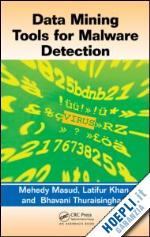Mehedy Masud is a postdoctoral fellow at the University of Texas at Dallas (UTD), where he earned his PhD in computer science in December 2009. He has published in premier journals and conferences, including IEEE Transactions on Knowledge and Data Engineering and the IEEE Data Mining Conference. He will be appointed as a research assistant professor at UTD in Fall 2012. Masud’s research projects include reactively adaptive malware, data mining for detecting malicious executables, botnet, and remote exploits, and cloud data mining. He has a patent pending on stream mining for novel class detection. Latifur Khan is an associate professor in the computer science department at the University of Texas at Dallas, where he has been teaching and conducting research since September 2000. He received his PhD and MS degrees in computer science from the University of Southern California in August 2000 and December 1996, respectively. Khan is (or has been) supported by grants from NASA, the National Science Foundation (NSF), Air Force Office of Scientific Research (AFOSR), Raytheon, NGA, IARPA, Tektronix, Nokia Research Center, Alcatel, and the SUN academic equipment grant program. In addition, Khan is the director of the state-of-the-art DML@UTD, UTD Data Mining/Database Laboratory, which is the primary center of research related to data mining, semantic web, and image/videoannotation at the University of Texas at Dallas. Khan has published more than 100 papers, including articles in several IEEE Transactions journals, the Journal of Web Semantics, and the VLDB Journal and conference proceedings such as IEEE ICDM and PKDD. He is a senior member of IEEE. Bhavani Thuraisingham joined the University of Texas at Dallas (UTD) in October 2004 as a professor of computer science and director of the Cyber Security Research Center in the Erik Jonsson School of Engineering and Computer Science and is currently the Louis Beecherl Jr. Distinguished Professor. She is an elected Fellow of three professional organizations: the IEEE (Institute for Electrical and Electronics Engineers), the AAAS (American Association for the Advancement of Science), and the BCS (British Computer Society) for her work in data security. She received the IEEE Computer Society’s prestigious 1997 Technical Achievement Award for "outstanding and innovative contributions to secure data management." Prior to joining UTD, Thuraisingham worked for the MITRE Corporation for 16 years, which included an IPA (Intergovernmental Personnel Act) at the National Science Foundation as Program Director for Data and Applications Security. Her work in information security and information management has resulted in more than 100 journal articles, more than 200 refereed conference papers, more than 90 keynote addresses, and 3 U.S. patents. She is the author of ten books in data management, data mining, and data security.












